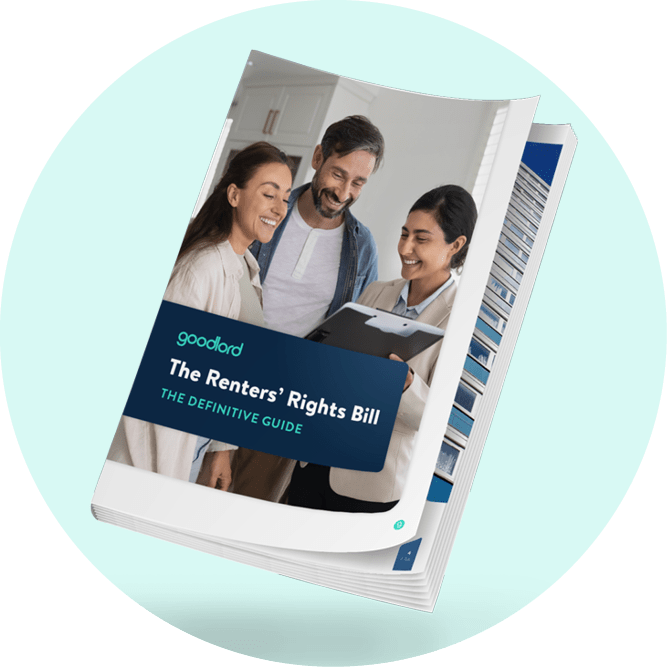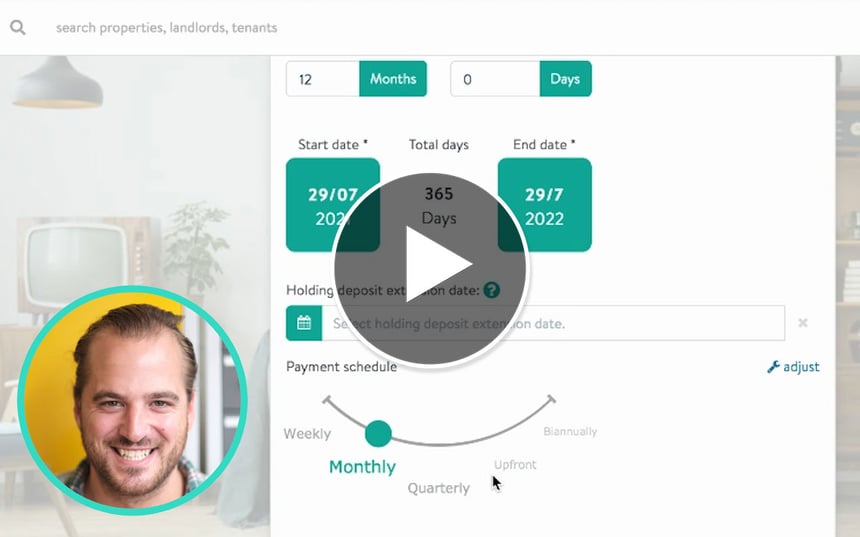Tenant reference checks: How to make your processes Renters’ Rights ready
The Renters’ Rights Act makes placing high-quality tenants in your landlords’ properties key. Automating tenant reference checks helps you do that.
If one thing’s clear about the Renters’ Rights Act, it’s this:
Evicting tenants will be significantly harder now that it has become law.
The abolition of Section 21 and fixed-term tenancies means landlords must use Section 8 to remove tenants from their properties.
As Section 8 notices rely on legal grounds for possession, courts have to process them, and courts are already plagued by delays. To make matters worse, investment in the system isn’t expected to help cope with this surge in demand.
As a result, the eviction process will take significantly longer.
But what does this have to do with tenant reference checks? With a robust tenant referencing process, letting agents can help their clients avoid court.
After all, reliable, high-quality tenants are less likely to breach tenancy agreements.
In this blog, we’ll explain how you can reinforce your tenant referencing processes so you can continue delivering quality services to your clients.
- What are tenant reference checks?
- Why should you automate tenant reference checks?
- How to automate reference checks (6 simple steps)
- Goodlord tenant reference checks: Key customer outcomes
- Conclusion: Automate tenant reference checks today
What are tenant reference checks?
Tenant reference checks are a range of processes used to verify a tenant's identity, financial information, and reputation. They help landlords — and letting agents acting on their behalf — reduce the risk of rent arrears, tenancy fraud, property damage, and eviction.
What are the different kinds of tenant reference checks?
Tenant reference checks can be split into four categories, which you can see below:
- Identity verification - ensures the tenant’s identity is genuine and matches their documents
- Credit - assesses a tenant’s financial history to understand whether they can reliably pay the rent
- Residential - gathers feedback from previous landlords to understand the tenant’s behaviour and treatment of properties
- Income - confirms a tenant’s employment is genuine and their income is sufficient to pay the rent
Unless landlords let their properties be handled independently, letting agents typically handle this process either manually or with a third-party provider.
Why should you automate tenant reference checks?
Because of the number of touchpoints in the tenant referencing process, it’s not scalable for letting agents to handle them manually.
Especially if you process a high volume of lettings, your agents will quickly become bogged down in admin, preventing them from focusing on generating new business.
Goodlord’s State of the Lettings Industry report reflects this, with 21% reporting they don’t have enough time to manage their workload.
What's more, 24% of agents highlight high stress levels, emphasising that agencies need to find automations wherever possible. Of course, the referencing process is no exception.
But staff efficiency and well-being aren't the only reasons you need to modernise your processes.
51% of landlords now cite compliance as a primary advantage of using a letting agent. To ensure you meet these expectations, you can’t rely on long email chains and shared spreadsheets to store key information.
Being unable to provide an audit trail puts you and your landlords at risk of fines, which could damage client relationships and threaten your business.
For example, Credas reported a 405% increase in fines for letting agencies who failed to follow right to rent best practices in 2024.
On this issue in particular, agents are more susceptible to tenancy fraud than software. Not because they're untrained or unskilled — simply because they're human.
With document-forging techniques becoming ever more sophisticated, it's almost impossible for the naked eye to verify the authenticity of identity documents.
By sticking with a manual process, you not only place undue pressure on your agents but you also risk bad actors slipping through the cracks.
How to automate reference checks (6 simple steps)
Software platforms like Goodlord centralise and securely store tenant referencing data, allowing you to reduce your agents’ workload while ensuring compliance. For the four different tenant reference checks, Goodlord gives them a “Pass,” “Conditional Pass,” or a “Fail”.
Keep reading to see how you can complete robust tenant reference checks in no time…
1 - Verify the tenant's identity

Applicants can upload their passports and other identity documents via desktop or mobile. If the document isn’t valid, they’ll be asked to re-upload.
Once your tenant submits their identity document(s) through our platform, they’re asked to take a selfie. Our platform then uses facial recognition technology to check the document and the selfie match. Goodlord's IDVT integration also checks that prospective tenants have the right to rent.
While this eliminates the need for in-person passport checks, agents still need to perform an imposter check either during a property viewing or via video call. This ensures the tenants applying are the people who’ll move into the property.
2 - Confirm the tenant's income

Traditionally, letting agents and landlords verified tenants’ income by asking them to provide:
- Their employment contract
- Bank statements for the last three months
- Direct confirmation from an employer
Or even all of the above. By contrast, with our Open Banking integration, agents can instantly access tenants’ income details directly from their bank account, significantly reducing paperwork.
From a compliance perspective, Goodlord further reduces the chances of tenancy fraud with HMRC, payroll, and National Fraud Database integrations.
The platform also ensures that:
- Tenants earn at least 2.5 times the annual rent
- Guarantors earn 3 times the annual rent
3 - Conduct a tenant credit check

Even if you’ve already verified your tenants’ income, it’s still important to conduct a credit check.
That’s because credit checks give you a picture of a tenant’s financial stability, and identify any issues like missed payments or County Court Judgements (CCJs). For some tenants — like students, who might not have a credit history — you’ll perform credit checks on guarantors, rather than the tenants themselves.
After Equifax analyses your tenants’ credit history, Goodlord suggests next steps based on their rating, as you can see in the image above.
4 - Conduct tenant residential checks

The best way to find out if an applicant is a good tenant is by contacting their previous landlord or letting agent. Goodlord automatically prompts these stakeholders to provide feedback, sending reminders until they do. This improves response rates, reduces delays, and saves your agents' time. Goodlord then analyses the feedback and gives tenants a rating, based on the criteria above.
5 - Review tenant referencing results

Both tenants and agents can review the progress of their applications at any time. Once identity, income, credit, and residential checks are complete, Goodlord gives an overall recommendation on whether you should proceed with the tenancy.
6 - Share the results with landlords

Finally, by reviewing the referencing report, you can see the overall outcome, as well as comments and justifications for the four checks. And the benefits go beyond providing an audit trail.
Sharing these reports with your landlords allows you to reach a collective decision on whether to proceed with a tenancy. As a result, your agency is less liable for blame, should the landlord experience issues with the tenant.
Goodlord tenant reference checks: Key customer outcomes
Anyone can promise the world when talking about their platform. So here’s what our customers have to say about the outcomes Goodlord’s tenant reference checks have delivered:
Reduce admin
Earlier, we outlined why reducing admin for agents is so important, especially in the Renters’ Rights Act context. Christopher Toynbee, Director at Gray & Toynbee, explains how Goodlord helps him do that:
"We'll often get questions from tenants as to how things are going or what stage they're at. We can log in quickly and see exactly what's happening with Goodlord. The updates from the referencing team are really good. The platform allows us to keep a really close eye on how the tenancies are progressing."
Ensure compliance
Throughout this blog, we’ve emphasised the importance of compliance. James Conway, Director at David Conway, explains how Goodlord has given him a clear audit trail of communications and documentation:
"I used to worry about human error but, with Goodlord, I've got the confidence to tell my landlord that compliance is taken care of," says James.
"Much of the process is automated, including documents sent at the right time in the process. The overall price of the platform and services is very good, and using technologies such as Open Banking gives an almost instant check on income criteria for referencing."
Conclusion: Automate tenant reference checks today
Even the most stably employed, reliable, and respectful tenant can fall on hard times, which means serving some Section 8 notices is inevitable as the Renters’ Rights Act becomes law.
Although no referencing software is a silver bullet, Goodlord’s market-leading platform comes close.
Our automations have a proven track record of reducing agent stress and reinforcing agencies’ compliance credentials. Here’s everything you get as part of our PRO Referencing package:
| Goodlord PRO Referencing | |
| Centralised, real-time dashboard | ✅ |
| Facial recognition technology | ✅ |
| Automatic applicant and referee chasing | ✅ |
| Automatic pass or fail rating | ✅ |
| Automatic report generation for audit trails | ✅ |
| ID Upgrade (IDVT) | ✅ |
| Credit checks performed by leading provider, Equifax | ✅ |
| Open Banking integration | ✅ |
| HMRC integration | ✅ |
| Payroll integration | ✅ |
To make your referencing processes Renters’ Rights ready, hit the button below 👇
This article is intended as a guide only and does not constitute legal advice. For more information, visit gov.uk.










